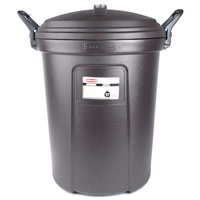 This past weekend, I was in Canadian Tire searching for a new garbage can. I stuck my head inside of a Rubbermaid bin in order to see how big it was, and I got a whiff of that distinctive odour exhaled by new plastic. The smell triggered a series of entrancing recollections for me, like the involuntary memory of his childhood that Proust experienced after biting into a cream-filled pastry in “In Search of Lost Time”. My memories were not from my youth, or from happy times spent amongst household plastics. Rather, I found that this Rubbermaid was evoking a bouquet from one of my favourite grapes: Riesling.
This past weekend, I was in Canadian Tire searching for a new garbage can. I stuck my head inside of a Rubbermaid bin in order to see how big it was, and I got a whiff of that distinctive odour exhaled by new plastic. The smell triggered a series of entrancing recollections for me, like the involuntary memory of his childhood that Proust experienced after biting into a cream-filled pastry in “In Search of Lost Time”. My memories were not from my youth, or from happy times spent amongst household plastics. Rather, I found that this Rubbermaid was evoking a bouquet from one of my favourite grapes: Riesling.
I love Riesling because it is a challenging wine. It’s a varied grape that defies easy characterization. It can display extreme sweetness, extreme dryness or extreme acidity. Sometimes, it just has extremely odd flavours (especially on the nose). It pushes the boundaries around what you may think a good wine should taste like. Yet, within all these varying extremes, good Rieslings have a similar elegance that is quickly recognizable. Best of all, good Riesling are not hard to find. It’s mainly grown in Germany, Austria and Alsace in France, regions that are famous for underpriced wine. Riesling has also found a home in many of the better Ontario wineries, where its talent for drawing the mineral flavours up from the soil is put to good use on our local limestone.
The Cave Spring Estate Riesling ($17.95, Ontario, Vintages Essential #286377) is an example of the bone-dry and highly acidic species of Riesling. It has a nose with a clean and pure quality that reminded me of freshly laundered linen. The palate is tart and bracing, like sucking on an underripe peach pit. The acid gives it an electric and seemingly endless finish that buzzes around your tongue. What is this sort of wine good for? The acidity makes it an excellent companion to all sorts of foods: spicy Thai dishes, steamed mussels, turkey, shrimp cocktail, grilled fish, or chicken salad sandwiches.
For an interesting contrast, try 2005 Karl Erbes Riesling Spatlese ($19.95, Vintages #49866 [Ed. Note: No longer available]). This is a “Spätlese”, which is made from grapes which have ripened longer and generated more sugar. This bottle is just as challenging as the Cave Spring, but in the opposite way. It was so mellow and mild in my mouth, it left me off-balance. It seemed too easy-going. The balance between its sweetness and gentle acidity undulated across my tongue and faded into a finish tasting like apple cider. Yet, within all this fleshiness was remarkable complexity, integration and finesse. This is a subtle wine in the classic German style.
Subtle, at least, in all ways but one: it had an outrageous nose: a trace of blossoms, a whiff of something almost like petrol, and – above them all – the odour of a brand new Rubbermaid.
Matthew Sullivan is a lawyer with the Department of Justice in Toronto. He writes a weekly blog entry here on lawandstyle.ca. The Short Cellar column appears in the print edition of Precedent. Matthew can be reached at matthew@lawandstyle.beta-site.ca

